Gods & Kings Korea Science
So among my raft of Civ 5 culture games, I also had to do science once, primarily targeting speed. The two science civs are Babylon and Korea. But Babylon sucks. +50% GPP is nowhere near 50% more Great Scientists. At best it can only be √150% = 122% as many because of the quadratically escalating total cost, but it's not even that, since half the great people come from other sources besides GPP so Babylon really only produces about one extra scientist. The very early GSci at Writing is nastily deceptive. The tech progress from the academy is illusory in the same manner as France acquiring early social policies - it fades to irrelevance as a component of endgame velocity.

Babylon is out by my reckoning; Korea is the way to go. And just for a change I picked a Lakes map.
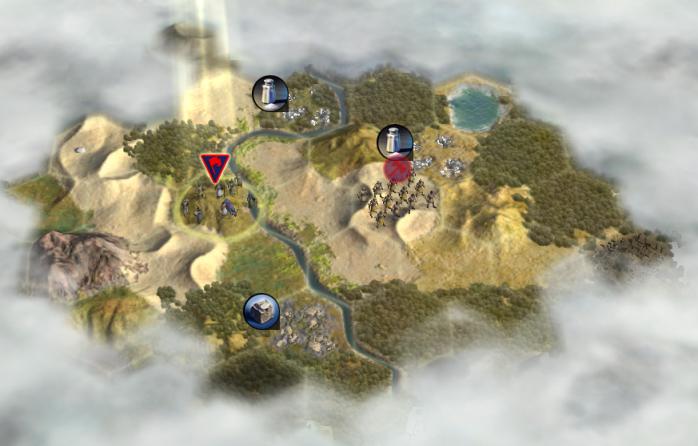
I wasn't looking for a desert start this time, but ended up with one anyway, heh. But the best feature here is the two salt resources. Salt is the best kind of tile by an insane margin. It is the only resource that adds THREE hard factors of production without a city building (one food base, one food and one hammer when mined.) And it is a sellable luxury. And it gets improved early at Mining, not with a second-level tech. So I did burn the two turns to move to the hill between the salts.
And heck, that was good enough to even start with Mining research rather than the standard Pottery. Which in turn means a monument earlier than usual, opening scout - scout - monument instead of putting off the monument until after the granary as I sometimes do.
Ruins: Spearman upgrade, Animal Husbandry, culture on turn 9 for Liberty opener, map, survivors to size 3, 85 gold, Masonry!

The 85 gold ruin came on turn 13. As usual, the instant it was possible, I took a loan from an AI to buy a worker. I'm quite sure that was correct. Salt demands that worker ASAfreakinP. Don't care if the Liberty worker policy is only 6 turns away. 6 turns of salt is 6 food 6 hammers and 60 gold worth of selling it, which is way more than the loan interest. In fact, we want both workers, purchased and Liberty. The fastest way to a settler was not the Liberty settler policy, it was selling the two salts and buying the settler.
A minor delay occurred when a barb warrior appeared, forcing my worker off the second salt for a few turns and forcing me to build a warrior delaying the granary. Well, these things happen. Turns out I got my settler by selling the 4-horse source and three embassies, purchasing the settler on turn 26.
Why'd I want that settler so much?
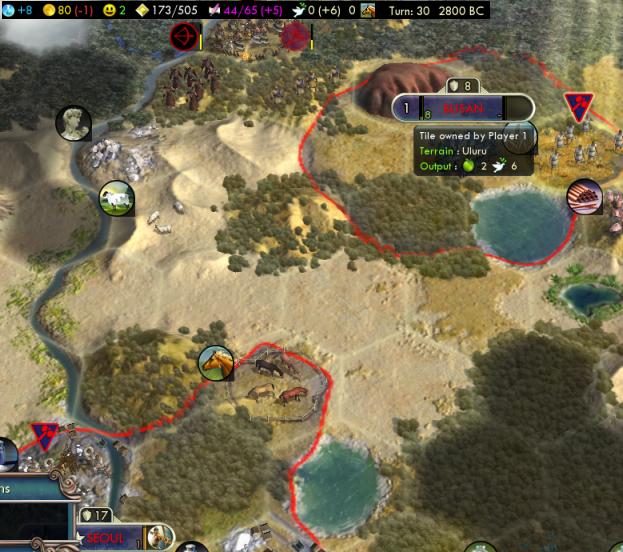
This spot up here. Wet wheat, another luxury to sell, oasis... and the best Natural Wonder in the game, Uluru. That thing will singlehandedly propel you to a pantheon and religion. It did, reaching the Pantheon on turn 35. I learned my lesson in the France game about picking a pantheon - best to just go directly for happy with Goddess of Love.
(Incidentally, I apologize for the blurry city names. That's an artifact of JPEG compression, that red and blue get smeared together. I can't fix that short of manually replacing the colors or using a much bigger image format. At least you won't have to repeatedly endure "Gangneung Style" jokes in your head from that city name.)
Anyway, the whole opening build order was scout - scout - [buy worker] - monument - warrior - granary - [buy settler] - archer - archer - Pyramids. I sold the second salt, although the gold sat on hand for a score of turns until accumulating enough to afford the settler... hate it when that happens. Had to wait for my first original worker loan to run out, then took another loan to buy this settler.
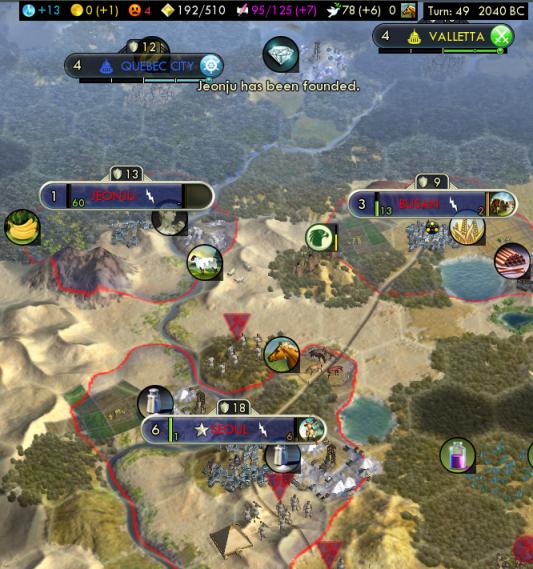
In a stroke of fantastic skill dumb luck, this settler founded on exactly the turn that my first salt sale ran out. Although it appears I'm at -4 happiness, in fact that terminating deal resolves before the production phase, and the cities received full food without losing any to anger. Speaking of food, you can also see Quebec City already allied, from a barbarian camp clear, starting the maritime food snowball. Valletta also credited me for the camp clear, and moved to alliance with a quest to build the Pyramids.
Next turn the copper mine finished, so I could sell another luxury. Salt or copper - selling salt is better, because the other salt will recycle back to my own use sooner.
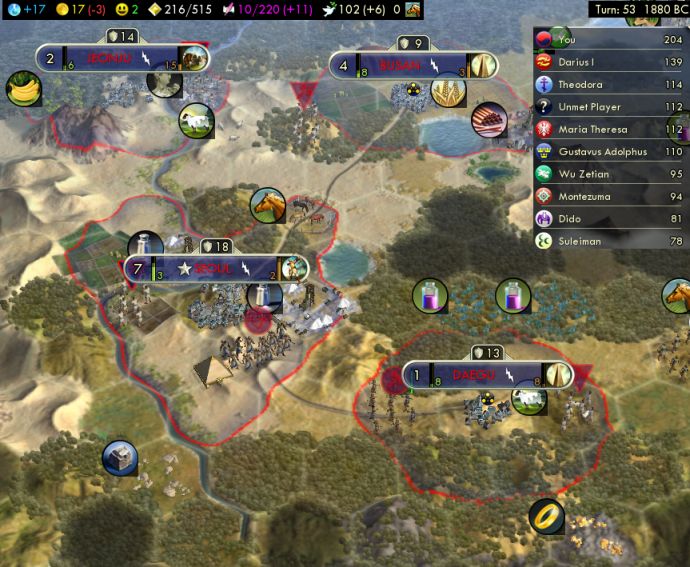
And then the Liberty settler arrived for this city. I've gone into a lot more depth than usual here on the early expansion phase, but I think that's useful to see now and again. Civ 5 does have strategic depth in directing the newborn early game snowball.
Glossing over some detail now, research proceeded to Construction to enter the classical era. Uluru gave me my religion at the early date of 1200 BC turn 70. I took more happy stuff, Ceremonial Burial and Religious Center.
By the way, it's really annoying how founding your religion cuts off new cities from automatically getting the pantheon. In fact it's actually probably correct to keep the prophet idle if you have more cities coming in the next few turns. Thanks to this, I decided I had to go with one missionary before enhancing the religion. The missionary would spread for not just one happy per city, but two, by bringing along the pantheon Goddess of Love along with Ceremonial Burial.
Valletta very helpfully provided a composite bow, which let me skip more military and keep expanding. Expand expand expand. Core cities built nothing but workers and settlers. New cities would do granary and monument, then workers. Except at times when bumping into the happy cap, then circuses and colosseums. Colosseums cost 50 hammers per happy, which sounds expensive in the early game... but they fast become the right thing to do. A size 7 city costs 60 more food to grow than a size 1 city, so a faster snowball is achieved by investing in 50 hammers of colosseum to grow the new city than by working 60 food in the old city.
I'd been filling up Liberty with social policies, but for my sixth policy on turn 89, I took the Tradition opener. Save Representation for policy seven to put the Golden Age after Chichen Itza. I correctly estimated that I'd earn seven policies before opening Rationalism, so the Tradition opener was the most useful place for the seventh. This Tradition opener is severely underrated for all types of games. It more than doubles cities' rate of cultural tile acquisition, cutting costs from over 100 per tile to around 40. Without Tradition, cities only acquire about six tiles before the game ends -- you can see that with city states in the later game, they only add about six tiles to their original first ring. I feel seriously crippled on expansion in any game that doesn't take the Tradition opener.
The Liberty finisher then did arrive, and the choice had to be a settled Great Scientist of course.
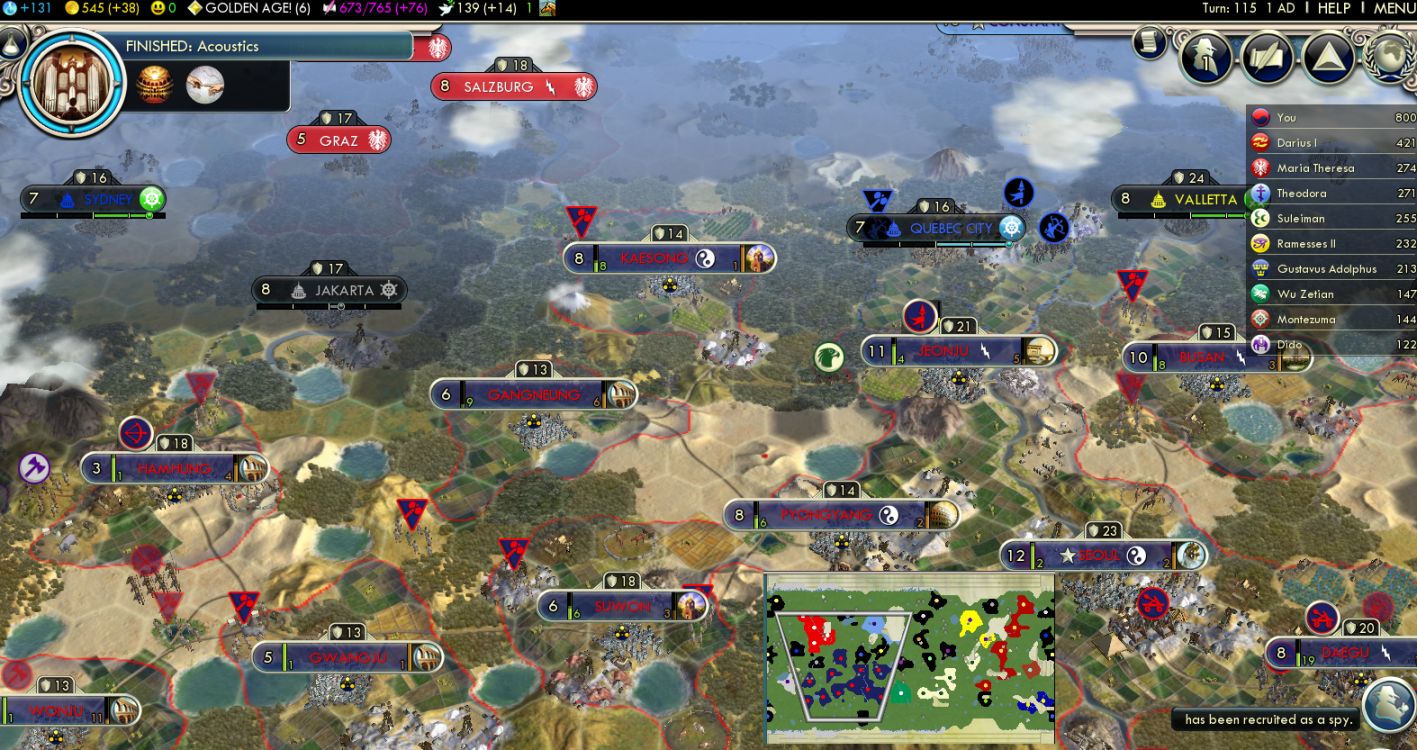
Here's the traditional 1 AD overview, with my 11 core cities founded (actually by about turn 95.) I stopped expanding here for happiness reasons, hitting the ceiling fairly hard now without much more on the horizon. There were no more reachable luxuries, and beyond my southern border was tundra not worth settling.
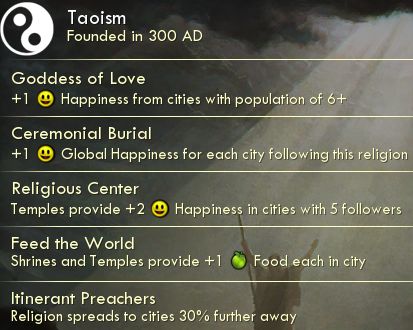 Happy continued to be constraining until the religion finally started spreading in earnest and the cities could build temples for Religious Center. I was building shrines and temples ahead of libraries - not sure if that was correct. Probably it would have been better to take a different belief that didn't need investment in the 100-hammer temple for happy. Well, since I had those buildings anyway, I went with Feed the World (+1 food from shrines and temples) at enhancement time.
Happy continued to be constraining until the religion finally started spreading in earnest and the cities could build temples for Religious Center. I was building shrines and temples ahead of libraries - not sure if that was correct. Probably it would have been better to take a different belief that didn't need investment in the 100-hammer temple for happy. Well, since I had those buildings anyway, I went with Feed the World (+1 food from shrines and temples) at enhancement time.
As research approached the Renaissance at Acoustics, I had this cheeky play simmering...

Aww crap. I missed by ONE TURN using the Oracle to sling a Renaissance Rationalism policy! Dang! If only Korea's research boost hadn't gotten indirectly nerfed by the changes to Research Agreements in G&K. RAs now depend on the combined beaker productivity of you and your partner... so for Korea's boost there is no partner and it comes out worth only half a real RA. The boosts for the library and university in Seoul had awarded only about 140 beakers each, leaving me short by that one critical turn.
Anyway, I reached Acoustics at precisely 1 AD, and the Rationalism opener followed two turns later. Here's my whole schedule for Rationalism.
- T117 Rationalism
- T132 Secularism
- T149 Free Thought
- T172 Scientific Revolution (right before my first RA matured)
- T190 Humanism
- T205 Sovereignty
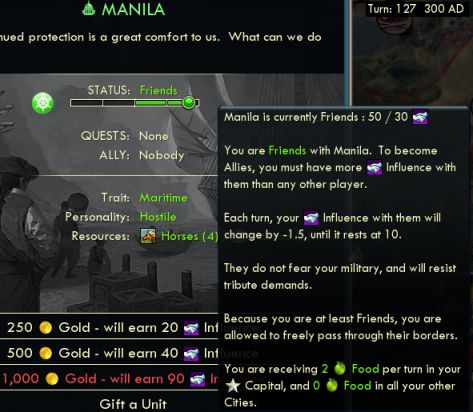
Golden Ages from Representation, happiness, and the Taj Mahal followed in quick succession, lengthened by Chichen Itza. Golden Ages mean, well, gold. Machu Picchu added dozens of income too. And the answer to what to buy just always always seems to be city-states. Like this - some random quest had just moved Manila to 50 influence. $500 would earn 19 turns of alliance, 19x11 = 209 food, that's a better ratio converting gold:food than would be converting gold:hammers with purchases. Plus some of that food goes through WLTKD. In fact, buying a city-state just for We Love The King Day purposes was also correct, getting something like 4 food times 5 cities times 20 turns, well worth the CS's cost.
Research continued to Banking for the Forbidden Palace, then on up to Scientific Theory, reaching the industrial age on T148 760 AD.
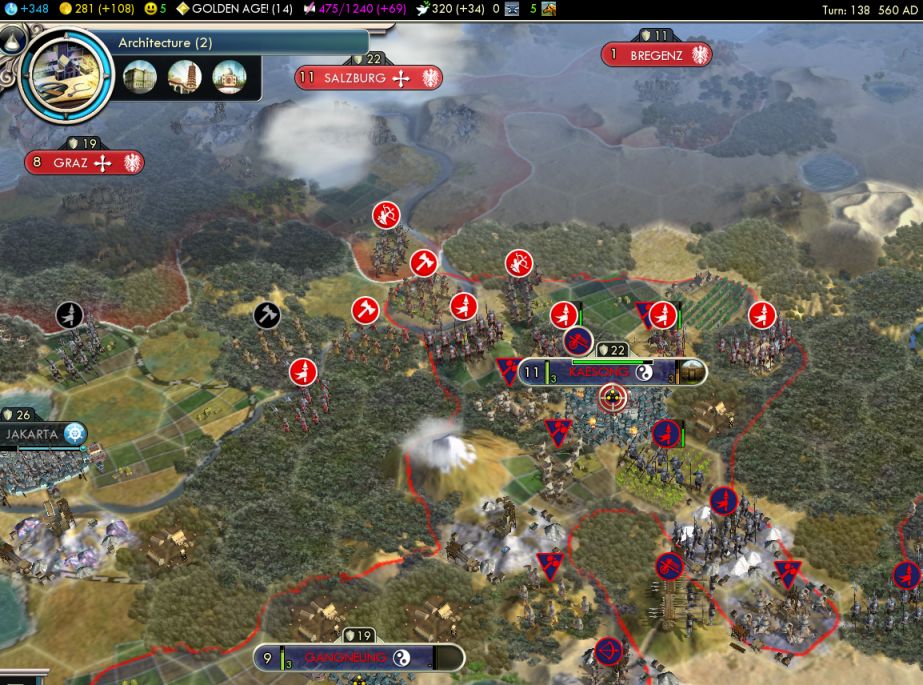
Presently I got my only war declaration of the game, from Austria. This was great news. The timing was perfect, just as I completed the Forbo and Notre Dame giving me the usual bubble of 25 happy to burn. All those units of mine had come from a pair of militaristic city-states that had fed me several quests.
I easily repelled that invasion and turned offensive. I ate Austria down to one bad city, annexing them all. We had the happy to spare, especially once Humanism hit. I was surprised to see how fast the conquered Austrian cities redeveloped. I bought the aqueducts and a granary or two, and 20 turns later they'd finished their own libraries and universities and were churning out science just like everybody else. They perfectly used up my surplus happiness and converted it into research and gold.
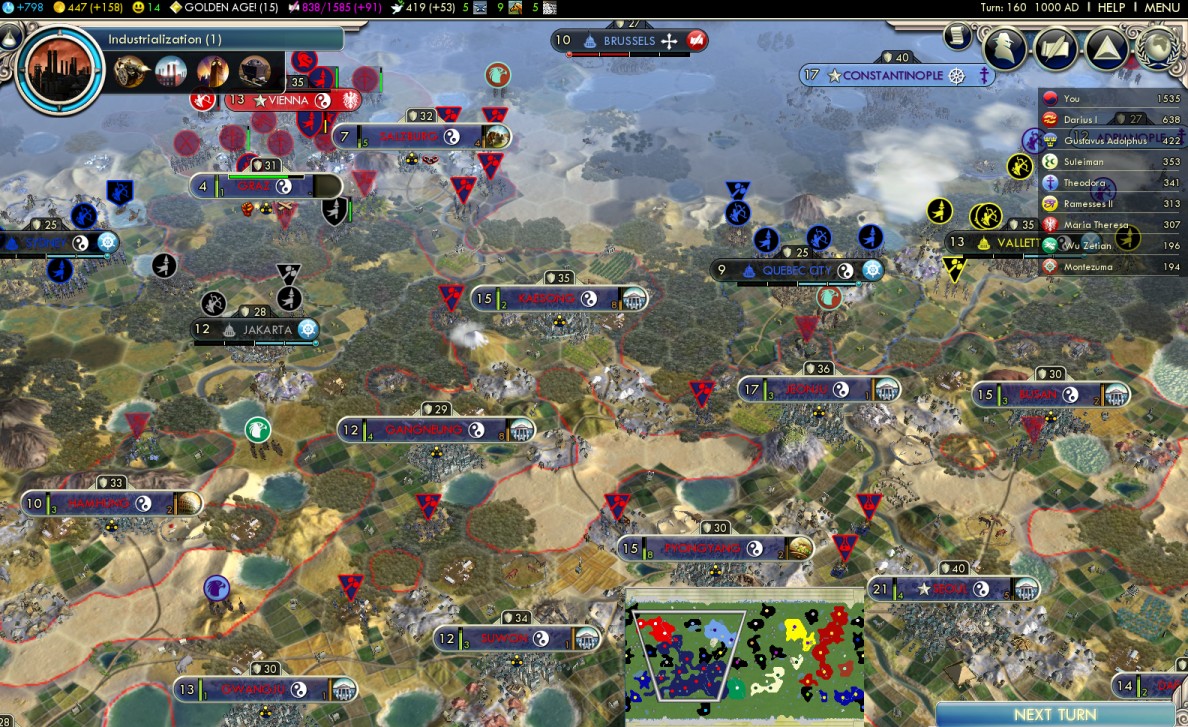
Here's the 1000 AD overview in the middle of that Austrian conquest.
Skipping over some uninteresting late game detail now, I naturally built Public Schools and continued on up to Plastics. Then Railroad was the next useful thing. Then of course it was the Giant Tech Valley Of Nothing But Military for an entire era.
I built lots of wonders pretty late, after Public Schools, dispersed over several cities. Taj, Sistine, Pisa Tower, Big Ben, Porcelain Tower, later Statue of Liberty and Eiffel Tower. (Wow, there's a lot of Towers in this game.) The Statue was primarily useful for production shifting, spend surplus hammers during the Military Tech Valley in order to quantum-tunnel them into the future, receiving back the hammers for spaceship parts.
Faith was now saved for Great Scientist purchases. Obviously there was no way a missionary at 500 cost could pay back a third of the 10000 beakers the 1500-faith Great Scientist will be worth. Except -- and this is kind of dumb -- it was better to let the faith accumulate with the scientists unpurchased and buy them at endgame rather than pay maintenance for them to sit around.

Heh, oops! Well, here was an amusing side thread. I ran a Great Prophet into barbarians, and then when I got military units to that camp, someone else had cleared it already.
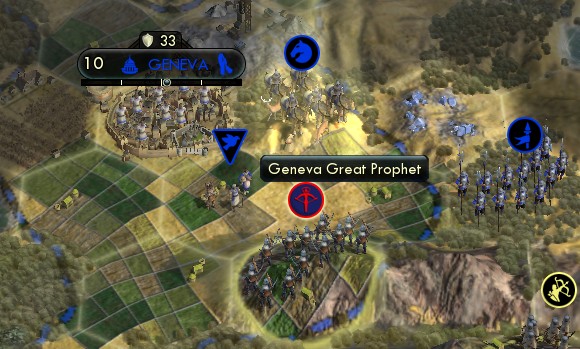
Aye, there he is. Now what? There's no option to ask for tribute "Give me my Prophet back". So I got mad and declared war on Geneva to recapture him. Then decided that as long as I was already the villain, might as well conquer and puppet Geneva for a few extra beakers.
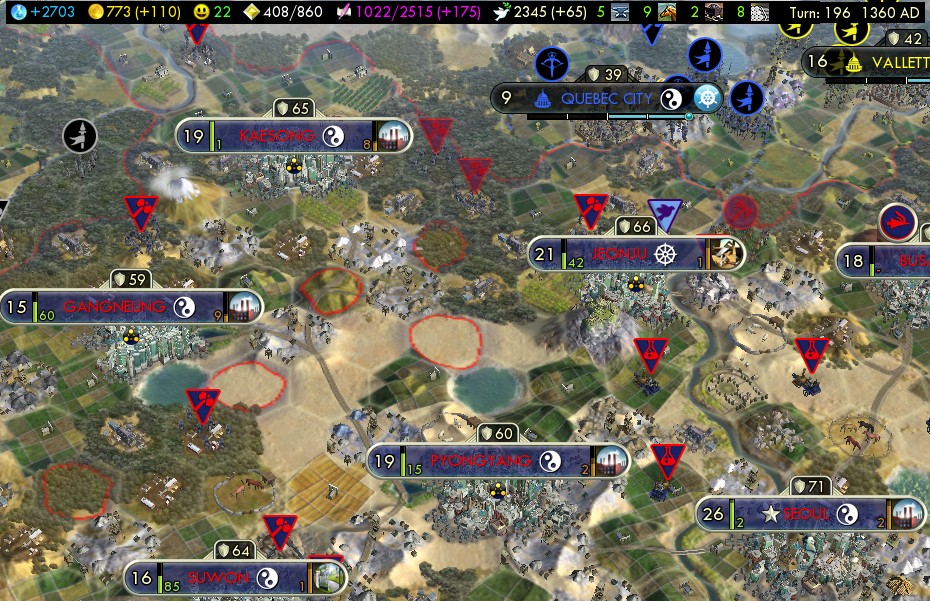
I keep mentioning saving Great Scientists for bulbs. In Gods & Kings, they do not lightbulb exactly one tech; rather they award beakers equal to the sum of your last 8 turns of beaker production, which can be less or more than one tech. Some advice says there's no need to save them now, since they always award 8 turns of research no matter when expended.
This advice is resoundingly false. What matters for science speed is endgame velocity, how fast you pick up the 120,000 beakers of the last two eras, not how fast you get to something like public schools. Bulbing a midgame scientist for 2000 beakers will never accelerate you by enough to make up the 20,000 beakers that can be achieved by an endgame bulb.
So conventional wisdom on CFC says to get to Plastics, build research labs, then start bulbing 8 turns later once the 8-turn history window is fully filled by the labs. Each city went max specialists after the lab, with the Statue of Liberty also now working, and even building and staffing amphitheaters just for the specialist slot.
Here's the problem with that conventional wisdom.
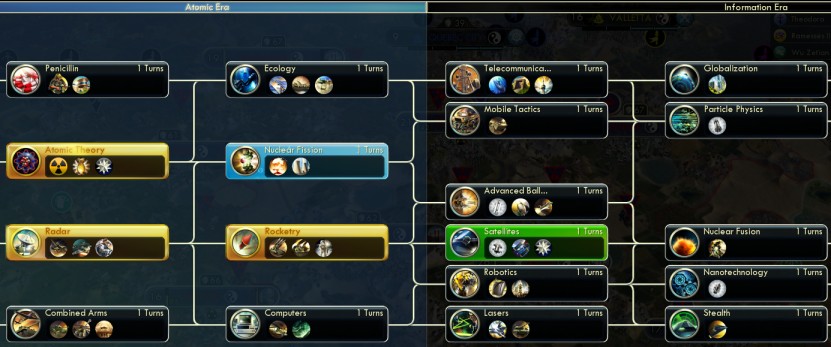
Notice how every tech says 1 turn? I got bottlenecked and clusterjammed on the fact that only one tech can be awarded each turn and with each bulb. The rest goes into overflow; you cannot discover a second tech at the same time with any of these methods. Each of my bulbs applied 20k beakers to a 10k beaker tech with the rest stacking up as overflow.
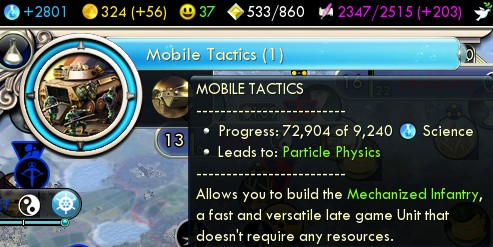
Holy insane crap! That is SEVENTY-TWO THOUSAND beakers of overflow that is backlogged and constricted from burning into actual techs!
And that's not all: I left a ton of techs on the table by other means. Never built Oxford! Never built National College for the Korea tech boost! Never built the Hubble Telescope!! Never reached the Rationalism finisher in time!!! That's another 60k beakers that never materialized! Yikes. So what this means is that Labs are too late to start bulbing; in fact right after Public Schools is probably correct for a bulb or three.
Anyway, let's salvage this. I sold all the research labs and public schools and universities, and pushed that cash into buying spaceship factories and power plants and forges. This was spookily reminiscent of the Alpha Centauri endgame, where technology research goes supernova and you blow through the last quarter of the tech tree in about five turns. And the game of optimizing becomes not dealing with actual production concerns, but rather working around the limitations of the chunkiness of the game system, right down to selling obsolete buildings.
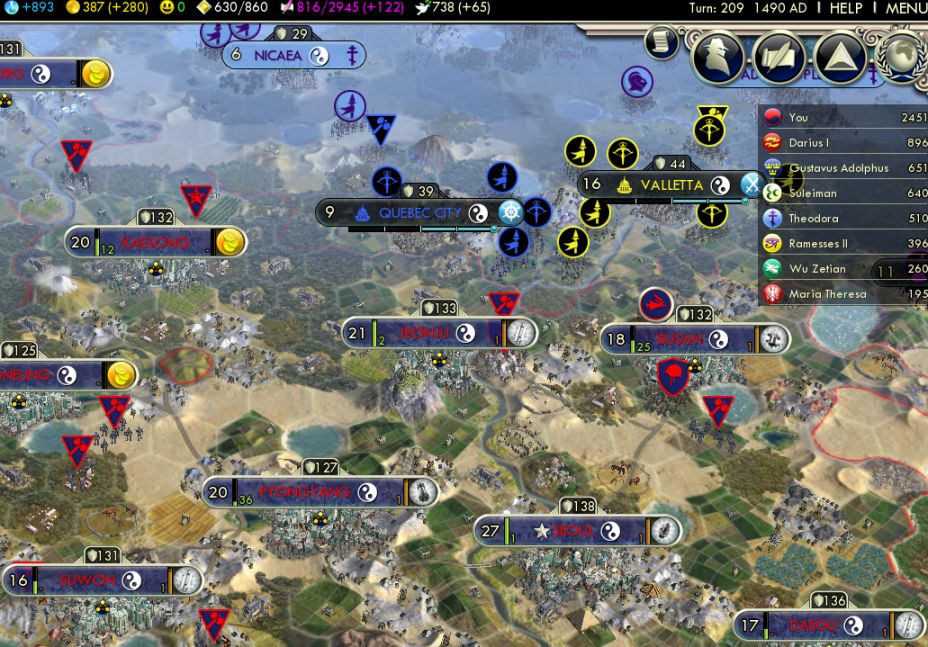
Finally, after two thoroughly uninteresting hours of micromanagement, I had all six spaceship parts completing together. Science Victory on turn 210 precisely 1500 AD.
I am not sure if I'm satisfied with that. Sub-200 science is known to be possible, and I blew probably twenty turns in that endgame research clusterfun. But I'm not sure it's worth playing another entire game just to fix that, since the rest of this one went very well. Besides, there's still culture to go exhibit.
 Happy continued to be constraining until the religion finally started spreading in earnest and the cities could build temples for Religious Center. I was building shrines and temples ahead of libraries - not sure if that was correct. Probably it would have been better to take a different belief that didn't need investment in the 100-hammer temple for happy. Well, since I had those buildings anyway, I went with Feed the World (+1 food from shrines and temples) at enhancement time.
Happy continued to be constraining until the religion finally started spreading in earnest and the cities could build temples for Religious Center. I was building shrines and temples ahead of libraries - not sure if that was correct. Probably it would have been better to take a different belief that didn't need investment in the 100-hammer temple for happy. Well, since I had those buildings anyway, I went with Feed the World (+1 food from shrines and temples) at enhancement time.















